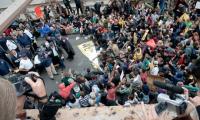Hundreds held by NYPD – including New York Times journalist – after attempted march across bridge ends in chaos
More than 700 people were arrested on the Brooklyn Bridge on Saturday evening during a march by anti-Wall Street protesters who have been occupying a downtown Manhattan square for two weeks.
The group, called Occupy Wall Street, has been protesting against the finance industry and other perceived social ills by camping out in Zuccotti park in New York.
During the afternoon a long line of protesters numbering several thousand snaked through the streets towards the landmark bridge across the East River with the aim of ending at a Brooklyn park.
However, during the march across the bridge groups of protesters sat down or strayed into the road from the pedestrian pathway. They were then arrested in large numbers by officers who were part of a heavy police presence shepherding the march along its path.
At one stage 500 protesters were blocked off by police on the bridge. At least one journalist, freelancer Natasha Lennard for the New York Times, was among those arrested. "About half way across the group of people who wanted to occupy the bridge launched their action and stepped into the road. They wanted to get arrested. It was sort of the idea," said Yaier Heber, one of the marchers.
But others said the sit-down protest appeared to happen only after the protesters were deliberately blocked off by police after actually being allowed onto the roadway. "They met the police line and ended up being arrested one by one," said Damon Eris, another protester.
The march ended in chaotic scenes with police buses driving up the bridge to be filled with arrested marchers. The packed buses then drove off to central booking. Meanwhile, other marchers waited at the bottom of the bridge's Manhattan side and cheered as some released protesters, or those who had escaped being blocked off, came back down. "Let them go! Let them go!" was a frequent chant.
It was a different scene from the night before when an equally large march had ended up at the city's police headquarters. That demonstration had been against the brutal treatment meted out by some police on protesters on a march the weekend before. Video of one senior police officer spraying pepper spray on female protesters went viral on the internet and drew widespread condemnation.
But the incident did help put the Occupy Wall Street movement into American newspapers and TV shows that had hitherto paid it little attention. The group, drawn from a wide range of backgrounds, say they are inspired by social movements in Spain and the Arab spring. Last week the protesters attracted numerous celebrity visits, including actor Susan Sarandon and film-maker Michael Moore. This week they are expected to get an injection of support from local labour unions.
The movement has also started to spread in significant numbers to several other major cities. On Saturday in Los Angeles hundreds of protesters marched on the city hall with the intention of starting a similar encampment. In Boston protesters have already started camping out in Dewey square, near the city's financial district. Unlike in New York, where protesters are not allowed to create shelter in Zuccotti park, Occupy Boston has been able to set up rows of tents.

